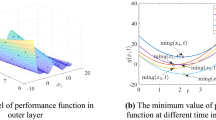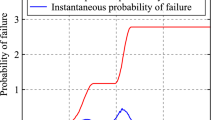Abstract
In practical engineering, many uncertain factors in loading or degradation of material properties may vary with time. Stochastic process modeling constitutes a suitable approach for describing these time-dependent uncertainties. By adopting this approach, however, the time-dependent reliability calculation is a great challenge owing to the complexity and the huge computational burden. This paper presents a new instantaneous response surface method t-IRS for time-dependent reliability analysis. Different from the adaptive extreme response surface approach, the proposed method does not need to build and update surrogate models separately at each time node. It first uses the expansion optimal linear estimation method to discretize the stochastic processes into a set of independent standard normal variables together with some deterministic functions of time. Time is then treated as an independent one-dimensional variable. Next, initial samples are generated by Latin hypercube sampling, and the corresponding response values are calculated and utilized to construct an instantaneous response surrogate model of the Kriging type. The active learning method is applied to update the Kriging surrogate model until satisfactory accuracy is achieved. Finally, the instantaneous response surrogate model is used to compute the time-dependent reliability via Monte Carlo simulation. Four case studies are utilized to demonstrate the effectiveness of the t-IRS method for time-dependent reliability analysis.









Similar content being viewed by others
References
Madsen HO, Krenk S, Lind NC. Methods of structural safety. Englewood Cliffs: Prentice-Hall; 1986.
Hasofer AM, Lind NC. Exact and invariant second-moment code format. J Eng Mech Div. 1974;100:111–21.
Rackwitz R, Flessler B. Structural reliability under combined random load sequences. Comput Struct. 1978;9:489–94.
Fishman GS. Monte Carlo: concepts, algorithms and applications. New York: Springer; 1996.
Sudret B. Meta-models for structural reliability and uncertainty quantification. In: Asian–Pacific symposium on structural reliability and its applications, Singapore; 2012.
Faravelli L. Response-surface approach for reliability analysis. J Eng Mech. 1989;115:2763–81.
Crestaux T, Maıtre OL, Martinez JM. Polynomial chaos expansion for sensitivity analysis. Reliab Eng Syst Saf. 2009;94:1161–72.
Sudret B. Global sensitivity analysis using polynomial chaos expansions. Reliab Eng Syst Saf. 2008;93:964–79.
Bourinet JM, Deheeger F, Lemaire M. Assessing small failure probabilities by combined subset simulation and support vector machines. Struct Saf. 2011;33:343–53.
Hurtado JE, Alvarez DA. Neural-network-based reliability analysis: a comparative study. Comput Method Appl M. 2001;191:113–32.
Huang X, Chen J, Zhu H. Assessing small failure probabilities by AK-SS: an active learning method combining kriging and subset simulation. Struct Saf. 2016;59:86–95.
Wang Z, Wang P. A maximum confidence enhancement based sequential sampling scheme for simulation-based design. J Mech Des. 2014;136:021006.
Miller RA. Thermal barrier coatings for aircraft engines: history and directions. J Therm Spray Tech. 1997;6:35–42.
Ditlevsen O. Stochastic model for joint wave and wind loads on offshore structures. Struct Saf. 2002;24:139–63.
Pindoriya NM, Jirutitijaroen P, Srinivasan D, Singh C. Composite reliability evaluation using Monte Carlo simulation and least squares support vector classifier. IEEE T Power Syst. 2011;26:2483–90.
Rice SO. Mathematical analysis of random noise. Bell Syst Tech J. 1944;23:282–332.
Wang Z, Chen W. Confidence-based adaptive extreme response surface for time-variant reliability analysis under random excitation. Struct Saf. 2016;64:76–86.
Engelung S, Rackwitz R, Lange C. Approximations of first passage times for differentiable processes based on higher order threshold crossings. Probab Eng Mech. 1995;10:53–60.
Rackwitz R. Computational techniques in stationary and non-stationary load combination—a review and some extensions. J Struct Eng. 1998;25:1–20.
Breitung K. Asymptotic approximations for the crossing rates of poisson square waves. In: Proceedings of the conference on extreme value theory and applications, Gaithersburg. NIST Special Publication 866. 1993;3:75–80.
Hagen O, Tvedt L. Vector process out-crossing as parallel system sensitivity measure. J Eng Mech. 1991;121:2201–10.
Andrieu-Renaud C, Sudret B, Lemaire M. The PHI2 method: a way to compute time-variant reliability. Reliab Eng Syst Saf. 2004;84:75–86.
Sudret B. Analytical derivation of the out-crossing rate in time-variant reliability problems. Struct Infrastruct Eng. 2008;4:353–62.
Zhang J, Du X. Time-dependent reliability analysis for function generator mechanisms. J Mech Des. 2011;133:031005.
Son YK, Savage GJ. Set theoretic formulation of performance reliability of multiple response time-variant systems due to degradations in system components. Qual Reliab Eng Int. 2007;23:171–88.
Mejri M, Cazuguel M, Cognard JY. A time-variant reliability approach for ageing marine structures with non-linear behaviour. Comput Struct. 2011;89:1743–53.
Hu Z, Du X. Time-dependent reliability analysis with joint upcrossing rates. Struct Multidiscip O. 2013;48:893–907.
Lutes LD, Sarkani S. Reliability analysis of systems subject to first-passage failure. NASA Technical Report No. NASA/CR-2009-215782; 2009.
Breitung K. Asymptotic crossing rates for stationary Gaussian vector processes. Stoch Process Appl. 1988;29:195–207.
Singh A, Mourelatos ZP, Li J. Design for lifecycle cost using time-dependent reliability. J Mech Des. 2010;132:1105–19.
Wang Z, Wang P. A new approach for reliability analysis with time-variant performance characteristics. Reliab Eng Syst Saf. 2013;115:70–81.
Hu Z, Du X. Mixed efficient global optimization for time-dependent reliability analysis. J Mech Des. 2015;137:051401.
Hu Z, Du X. A sampling approach to extreme value distribution for time-dependent reliability analysis. J Mech Des. 2013;135:071003.
Hu Z, Du X. Reliability analysis for hydrokinetic turbine blades. Renew Energ. 2012;48:251–62.
Sudret B, Kiureghian AD. Stochastic finite elements and reliability—a state-of-the-art report. Des End User Interfaces. 2000;30:22–5.
Loève M. Probability Theory I. New York: Springer; 1977.
Zhang J, Ellingwood B. Orthogonal series expansions of random fields in reliability analysis. J Eng Mech. 1994;120:2660–77.
Li C, Kiureghian AD. Optimal discretization of random fields. J Eng Mech. 1993;119:1136–54.
Santner TJ, Williams BJ, Notz W. The design and analysis of computer experiments. Berlin: Springer; 2003.
Giunta AA. Aircraft multidisciplinary optimization using design of experiments theory and response surface modeling methods (dissertation). Blacksburg (Virginia): Virginia Polytechnic Institute and State University; 1997.
Simpson TW, Mauery TM, Korte JJ, Mistree F. Comparison of response surface and kriging models for multidisciplinary design optimization. Am Inst Aeronaut Astronaut. 1998;98:1–16.
Giunta AA, Watson LT, Koehler J. A Comparison of approximation modeling techniques: polynomial versus interpolating models. In: Proceedings of the 7th AIAA/USAFETY/NASA/ ISSMO symposium on multidisciplinary analysis and design. 1998;392–404.
Sn Lophaven HNJS. DACE – A MATLAB Kriging Toolbox – Version 2.0.; 2002.
Echard B, Gayton N, Lemaire M. AK-MCS: an active learning reliability method combining kriging and Monte Carlo simulation. Struct Saf. 2011;33:145–54.
Zhang D, Han X, Jiang C, Liu J, Li Q. Time-dependent reliability analysis through response surface method. J Mech Des. 2017;139:041404.
Jiang C, Huang XP, Han X, Zhang DQ. A time-variant reliability analysis method based on stochastic process discretization. J Mech Des. 2014;136:091009.
Hawchar L, Soueidy CPE, Schoefs F. Principal component analysis and polynomial chaos expansion for time-variant reliability problems. Reliab Eng Syst Saf. 2017;167:406–16.
Ferreira AJM. MATLAB codes for finite element analysis. Netherlands: Springer; 2009.
Gomes HM, Awruch AM. Comparison of response surface and neural network with other methods for structural reliability analysis. Struct Saf. 2004;26:49–67.
Cherkassky V, Ma Y. Practical selection of SVM parameters and noise estimation for SVM regression. Neural Netw. 2004;17:113–26.
Jiang SH, Li DQ, Phoon KW. A comparative study of response surface method and stochastic response surface method for structural reliability analysis. Eng J Wuhan Univ. 2012;45:46–53 (in Chinese).
Wang L, Wang X, Su H, Li G. Reliability estimation of fatigue crack growth prediction via limited measured data. Int J Mech Sci. 2017;121:44–57.
Wang L, Wang X, Wu D, Xu M, Qiu Z. Structural optimization oriented time-dependent reliability methodology under static and dynamic uncertainties. Struct Multidiscip O. 2018;57:1533–51.
Wang L, Wang X, Wu D, Zhang X. Non-probabilistic time-variant reliability assessment (NTRA) for the active control of vibration systems with convex uncertainties. ISAT. 2018;83:276–89.
Acknowledgements
This work is supported by the National Natural Science Foundation of China (Nos. 11572134 and 11832013).
Author information
Authors and Affiliations
Corresponding authors
Rights and permissions
About this article
Cite this article
Li, J., Chen, J., Wei, J. et al. Developing an Instantaneous Response Surface Method t-IRS for Time-Dependent Reliability Analysis. Acta Mech. Solida Sin. 32, 446–462 (2019). https://doi.org/10.1007/s10338-019-00096-5
Received:
Revised:
Accepted:
Published:
Issue Date:
DOI: https://doi.org/10.1007/s10338-019-00096-5




